Brownstone is a type of sandstone utilized in the construction of facades in the 19th century. Originally these stones were cut thin pieces and adhered to buildings. Nowadays the restoration of replacing the brownstone façade has changed, and most buildings are resurfaced with a pigmented mixture of stucco concrete instead.
When your brownstone façade calls for repair, it can be an elaborate and costly endeavor. If you are dealing with minor cracks, a patching job may be possible. Though it will be difficult to match the aged stucco with the fresh stucco. Due to the costs of “re-brownstoning”, owners will often just paint their facades. Stripping and power washing the paint later on is not always possible, in particular if the façade has too many decaying pieces. This will only cause more damage to your façade.
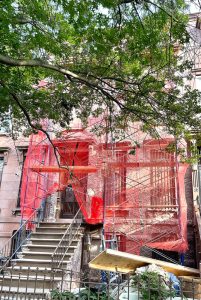 When you do decide to resurface the entire façade there are many considerations. If you are on a landmark block you will need to file for landmark approval before you can proceed with any work to the front of your building. They will require architectural submissions showing the original design and exact details of the façade. They will request samples of the pigment that will be utilized in the process and you will need licensed insured contractors for this type of work. A scaffold and scaffold permit will be required as well during the course of the work which will be taken care of by the contractor and filed with DOB. If your project is not on a landmark block, the application process will not be needed but you will still need to file the work with DOB for a scaffold permit.
When you do decide to resurface the entire façade there are many considerations. If you are on a landmark block you will need to file for landmark approval before you can proceed with any work to the front of your building. They will require architectural submissions showing the original design and exact details of the façade. They will request samples of the pigment that will be utilized in the process and you will need licensed insured contractors for this type of work. A scaffold and scaffold permit will be required as well during the course of the work which will be taken care of by the contractor and filed with DOB. If your project is not on a landmark block, the application process will not be needed but you will still need to file the work with DOB for a scaffold permit.
Once the job is permitted, scaffold is installed, and the process of removing the crumbling layer down to the solid concrete. 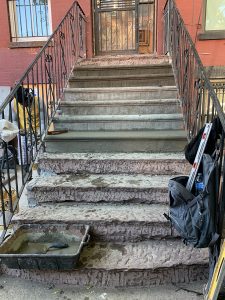 Then comes creating a jagged pattern with the original concrete so that the slurry and scratch coat can adhere afterward. It is also crucial, like any cement work, that this work occurs when the temperature is above freezing so it may cure properly.
Then comes creating a jagged pattern with the original concrete so that the slurry and scratch coat can adhere afterward. It is also crucial, like any cement work, that this work occurs when the temperature is above freezing so it may cure properly.
Next is the process of creating a slurry coat, which is a porous stucco concrete coat to which the scratch coat can adhere. The scratch coat recreates all shapes of sills, lintels, and floral and leaf carvings needed which existed in the original façade.
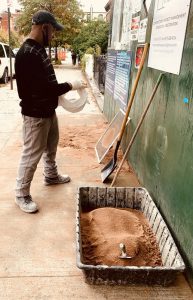 This coat is jagged and scratched and rough so that the final smooth brownstone can adhere correctly. When this is complete it needs a minimum of four weeks to cure and become strong and then a new brownstone coat begins.
This coat is jagged and scratched and rough so that the final smooth brownstone can adhere correctly. When this is complete it needs a minimum of four weeks to cure and become strong and then a new brownstone coat begins.
It is important to have the contractor provide samples of the pigment they will be using on the façade. If the building is landmarked the pigment will be specified and exact to the original color. On non-landmarked blocks, I have found the pigment color too pink or too bright brown. It is important to replicate the original brownstone tone which has a muted medium brown. The patch you choose can be a little brighter as it will tone down with the acid wash at the end.
The brownstone finish coat is true craftsmanship. Not only do they need to apply the exact layer evenly on the entirety of the façade,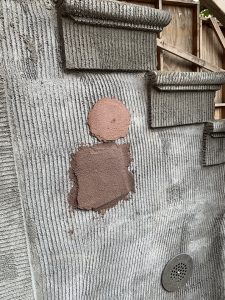 the intricate pedestals, columns, and floral designs around the doorways, window lintels, and other areas must be recreated. Make sure to view the contractor’s prior work to ensure that they have the experience and know-how for this sculptural work as well.
the intricate pedestals, columns, and floral designs around the doorways, window lintels, and other areas must be recreated. Make sure to view the contractor’s prior work to ensure that they have the experience and know-how for this sculptural work as well.
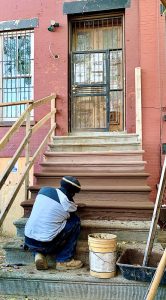 Once they have completed the finish coat it will need several weeks to cure. When it has cured it will be acid washed with muriatic acid throughout the entire façade which will remove any white streaks from the dried concrete, and will even out the pigment and tone.
Once they have completed the finish coat it will need several weeks to cure. When it has cured it will be acid washed with muriatic acid throughout the entire façade which will remove any white streaks from the dried concrete, and will even out the pigment and tone.
Then you can stand back and enjoy your magnificent and majestic façade!
If you are looking for advice in any part of evaluating a fixer upper, please feel free to contact me for resources and assistance at townhousetherapytati@gmail.com or call (917) 697-0117.
